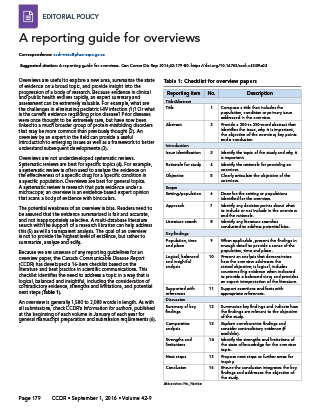Archived - Overviews reporting guide - 2016

 Download this article as a PDF (886 KB - 2 pages)
Download this article as a PDF (886 KB - 2 pages)Published by: The Public Health Agency of Canada
Issue: Volume 42-9: Scientific writing
Date published: September 1, 2016
ISSN: 1481-8531
Submit a manuscript
About CCDR
Browse
Volume 42-9, September 1, 2016: Scientific writing
Editorial Policy
A reporting guide for overviews
Correspondence
Suggested citation
A reporting guide for overviews. Can Comm Dis Rep 2016;42:179-80. https://doi.org/10.14745/ccdr.v42i09a03
Overviews are useful to explore a new area, summarize the state of evidence on a broad topic, and provide insight into the progression of a body of research. Because evidence in clinical and public health evolves rapidly, an expert summary and assessment can be extremely valuable. For example, what are the challenges in eliminating pediatric HIV infectionFootnote 1? Or what is the current evidence regarding prion disease, which was once thought to be extremely rare, but have now been linked to a much broader group of protein-misfolding disorders that may be more common than previously thoughtFootnote 2? An overview by an expert in the field can provide a useful introduction to emerging issues as well as a framework to better understand subsequent developmentsFootnote 3.
Overviews are not underdeveloped systematic reviews. Systematic reviews are best for specific topics Footnote 4. For example, as systematic review is often used to analyze the evidence on the effectiveness of a specific drug for a specific condition in a specific population. Overviews are best for general topics. A systematic review is research that puts evidence under a microscope; an overview is an evidence-based expert opinion that scans a body of evidence with binoculars.
The potential weakness of an overview is bias. Readers need to be assured that the evidence summarized is fair and accurate, not inappropriately selective. A multi-database literature search with the support of a research librarian can help address thisFootnote 5 as will a transparent analysis. The goal of an overview is not to provide the highest level of evidence, but rather to summarize, analyze and edify.
Because we are unaware of any reporting guidelines for an overview paper, the Canada Communicable Disease Report (CCDR) has developed a 16-item checklist based on the literature and best practice in scientific communications. This checklist identifies the need to address a topic in a way that is logical, balanced and insightful, including the consideration of contradictory evidence, strengths and limitations, and potential next steps (Table 1).
An overview is generally 1,500 to 2,000 words in length. As with all submissions, check CCDR's Information for authors, published at the beginning of each volume in January of each year for general manuscript preparation and submission requirementsFootnote 6.
| Reporting item | No. | Description |
|---|---|---|
| Title/Abstract | ||
| Title | 1 | Compose a title that includes the population, condition or primary issue addressed in the overview. |
| Abstract | 2 | Provide a 200 to 250-word abstract that identifies the issue, why it is important, the objective of the overview, key points and a conclusion. |
| Introduction | ||
| Issue identification | 3 | Identify the topic of the study and why it is important. |
| Rationale for study | 4 | Identify the rationale for providing an overview. |
| Objective | 5 | Clearly articulate the objective of the overview. |
| Scope | ||
| Setting/population | 6 | Describe the setting or populations identified for the overview. |
| Approach | 7 | Identify any decision points about what to include or not include in the overview and the rationale. |
| Literature search | 8 | Identify any literature searches conducted to address potential bias. |
| Key findings | ||
| Population, time and place | 9 | When applicable, present the findings in enough detail to provide a sense of the population, time and place. |
| Logical, balanced and insightful analysis | 10 | Present an analysis that demonstrates how the overview clearly addresses the stated objective; is logical, includes countervailing evidence when indicated to provide a balanced view, and provides an expert interpretation of the literature. |
| Supported with references | 11 | Support assertions and facts with appropriate references. |
| Discussion | ||
| Summary of key findings | 12 | Summarize key finding and indicate how the findings are relevant to the objective of the study. |
| Comparative analysis | 13 | Explore corroborative findings and consider contradictory evidence (if available). |
| Strengths and limitations | 14 | Identify the strengths and limitations of the state of knowledge for the overview topic. |
| Next steps | 15 | Propose next steps or further areas for inquiry. |
| Conclusion | 16 | Ensure the conclusion integrates the key findings and addresses the objective of the study. |